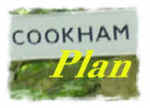
The Cookham Plan
TRANSPORT AND TRAFFIC
| MAIN REPORT INDEX | TRAFFIC AND TRANSPORT INDEX |
Members of the Working Group
Mike and Bernadette Clark (Joint Leaders)
David Hall
Gavin Hall
Gordon Harris
Jim Peck
Tim Pottage
The interests of Members were declared and do not conflict with the contents of this report.
The recommendations of the Working Group were accepted by the Steering Committee and are reflected in The Cookham Plan 2008.
1. Data:
The Working Group used the following data, available as appendices to the report, to help reach its conclusions and recommendations:
-
Public responses from the Pinder Hall Launch meeting.
-
The Transport and Traffic Healthcheck report.
-
The Village Questionnaire.
-
The Transport and Traffic survey of businesses in the Cookhams.
-
School Access reports.
-
Public Traffic flow surveys.
-
Public transport timetables and published Crossrail plans.
-
Working Group Parking Survey.
-
Photographic evidence.
-
Feedback from Steering Group meetings and workshops.
2. Demographic Assumptions:
The Working Group concluded that there is insufficiently robust external data on which to base a reliable set of demographic assumptions. The proposals, therefore assume that over the medium to long term (5 – 20 years) the number of traffic movements through the Cookhams will increase by c2% pa. The assumed reduction in local demand for primary school places will be offset by Local Education authority (LEA) school placements policy.
3. Underlying Planning Assumptions:
Due to its unique position in a rural, riverside setting, with National Trust (NT) land, only 30 miles from central London and easily accessible by road and rail, Cookham acts as a magnet to new residents and to casual visitors. Its local geography, as one of very few river bridging points, condemns it to be a focal point for through traffic.
Its infrastructure, including road and parking capacity, poor public transport and limited residential and business off-road parking, mean it is incapable of meeting the current demands made of it. Any plan must address these problems, not try to ignore them. Compromises are inevitable in meeting future needs.
These proposals are based on the following key premises:
-
Developments in Maidenhead impact directly on the Cookhams and the Cookham Village Plan must be considered in any larger Maidenhead plan.
-
Demand currently exceeds capacity.
-
Any Village Plan for transport and traffic must accept the impact of any increased demand on an overstretched and inappropriate infrastructure. No further housing development should be considered until a clear Transport and Traffic plan is in place.
-
The Plan must have as its first priority the resolution of existing problems for residents, businesses and visitors. Economic and social criteria must be balanced with the environmental, and cause with remedy.
-
The Royal Borough of Windsor of Maidenhead (RBWM) will be key in developing a coherent overall plan, linking all the elements set out in Point 4 (see below).
4. Proposals:
The Working Group identified 4 user based areas for consideration:
1) Parking
2) Safety
3) Congestion
4) Public transport.
4.1. Parking:
-
The implementation of a decriminalised parking regime must be drawn up in consultation with local businesses and residents. If strictly implemented the present restrictions would produce chaos.
-
Part of any parking plan must be the provision of significant extra public parking in critical areas: Lower Road, High Road, High Street and Cookham Moor.
-
Reserved parking must be provided in the above areas for residents and business employees. It is proposed that negotiations are conducted with willing owners of private parking spaces to provide rented and restricted access parking for these purposes.
-
A new parking/business/public transport hub at Cookham Rise (covers also Safety, Congestion and Public Transport.)
4.2. Safety:
-
A one way road system around the Pound, using Poundfield and Terries Lanes, with a widened footpath through the Pound. This resolves issues of both congestion and pedestrian / cyclist safety in the Pound.
-
A drop off and access point for Cookham Nursery School.
-
New, safe footpath access to rear of Holy Trinity School.
-
New car drop off and access to rear of H. T. School.
-
New car drop off and access at Cookham Rise School, linked to additional public parking (see 4.1 above).
-
New car drop off point at Herries School.
-
Traffic lights at railway bridge in Maidenhead Road.
-
Stricter enforcement of speed limits.
-
Clearer signage
4.3. Congestion:
-
One way system around Pound. (See also Safety)
-
Additional and alternative parking to relieve restriction in bottlenecks.
-
RBWM to re-assess classification of through roads on basis of increased traffic use – allocation of funding for road improvements.
-
Traffic "throats" at Cookham Bridge to limit vehicle size.
-
Reduction of local traffic demand by better public transport provision.
-
Weight limitation on delivery vehicles visiting High Street, Cookham Rise and Lower Road areas.
4.4. Public Transport:
-
Development of integrated transport and parking hub at Cookham Station.
-
Coordinated timetables and provision of "on demand" minibus and taxi services to link station to Cookham Dean and Whiteladyes Lane and public bus routes.
5. Rejected Proposals:
Based on consultation with the Borough and independent consultants the following proposals, which received public support, were not included in the final proposals;
-
Southern bypass – cost; planning practicality; diversion of attention from other, more deliverable solutions; impractical unless linked to major road development through Bourne End; lead time (>20years?); threat to Green Belt.
-
Footpath to north of Pound. Access problems at eastern end. Personal safety. Second best to one way road proposal.
-
School Lane one way system. School rear access proposal provides better long term solution for combined car and pedestrian access, linked to pedestrian safety.
-
Two way traffic at Cookham Bridge. The existing "intelligent" lights operate well. To provide a long term solution would require a major rebuilding project, disproportionate to the problem. See also comments on Southern By-Pass, above.